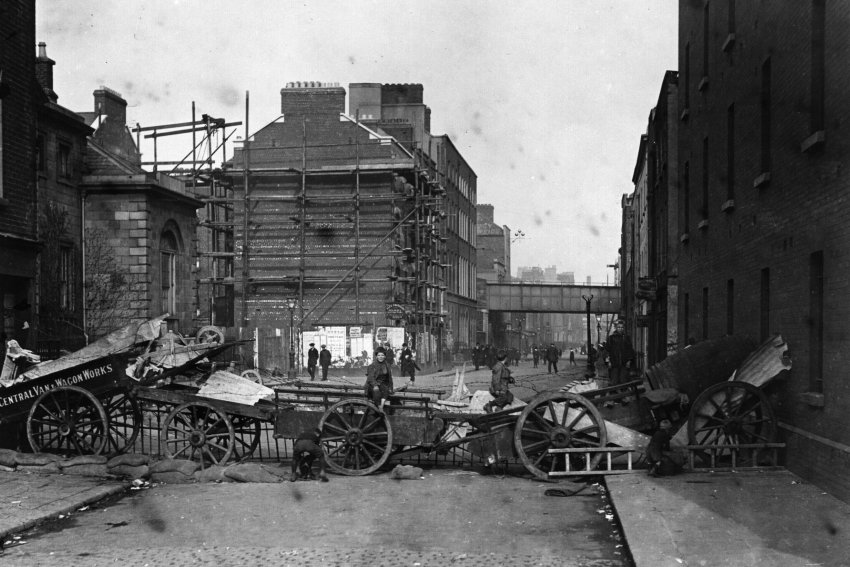THE 1916 Easter Rising is one of the most vital events in Irish history.
Rebel natives rose up against occupying British forces in an inspirationally daring attempt to demand, nay take their independence.
Though the Rising ultimately failed, seeds were sewn over that epic six-day period that would eventually lead Ireland away from subjugation, and toward the modern, proud Republic we know today.
Having covered the events which ultimately brought about the need for an insurrection, as well as the first day of the Rising earlier this week, today we're moving our focus to the second and third days of the rebellion.
British forces, who were initially caught by surprise when the attack began, had re-organised themselves and were ready to strike back at the insurrectionists and take back control of the city.
While the Irish had fought valiantly to gain the upper hand on the first day, British reinforcements were on the way.
Martial Law declared in Dublin
Irish rebels had established a headquarters at Dublin's General Post Office (GPO), where the 'Proclamation of the Irish Republic' was announced out by president Pearse the day before.
British soldiers had regrouped and reorganised themselves, particularly once reinforcements arrives, and set up for counterattacks from all five army barracks on the edge of the city.
Fighting erupted again as day broke, and the British Government declared martial law in Ireland.
The British, having been caught off guard the day before by the rebels, were still unsure of the size of the force they were up against. Secrecy and subtlety would serve as they rebels' best friends, if only they could hold on to both.
That being said, the British set out to re-take key areas of Dublin, cautiously.
 Irish Volunteers barricade Townsend Street, Dublin, to slow down the advance of troops, during the Easter Rising.
Irish Volunteers barricade Townsend Street, Dublin, to slow down the advance of troops, during the Easter Rising.With just 1,200 volunteers, the Irish rebels were glaringly outmanned and outgunned. They had hoped members of the public would rise and stand beside them as the rebellion began, but the hastiness of the first day cost them dearly.
Having been attacked there by the rebels the day before, British forces moved in to retake Dublin Castle. Brigadier-General William Lowe, who was leading the British forces, mistakenly believed the Irish rebels has based themselves at Liberty Hall, and taking the Castle would allow them to isolate the Hall from the rest of the rebel forces.
Before midday, both the Castle and the Hall were retaken by the British, though they were met with little resistance.
Fighting erupted along the northern edge of the city centre in the afternoon. In the northeast, British troops left Amiens Street railway station in an armoured train, to secure and repair a section of damaged tracks. They were attacked by rebels who had taken up position at Annesley Bridge.
After a two-hour battle, the British were forced to retreat and several soldiers were captured. At Phibsborough, in the northwest, rebels had occupied buildings and erected barricades at junctions on the North Circular Road. The British summoned 18-pounder field artillery from Athlone and shelled the rebel positions, destroying the barricades. After a fierce firefight, the rebels withdrew.
Pearse pleads for help
That afternoon Pearse walked out into O'Connell Street with a small escort and stood in front of Nelson's Pillar. As a large crowd gathered, he read out a 'manifesto to the citizens of Dublin,' calling on them to support the Rising.
They needed all the help they could get. Rebel forces had crucially failed to secure either of Dublin's two main railway stations or either of its ports. This allowed the British to bring thousands of reinforcements from England by sea, and from Northern Ireland by rail over the coming days, and by the end of the week they would outnumber the rebels 16 to one.
At the time, Dublin was considered the 'second city' of the British Empire, and some rebel commanders, particularly James Connolly, refused to believe the British would shell and damage such an important town. How wrong they were.
A military patrol vessels, Helga, sailed up the River Liffey to shell key rebel strongholds at Liberty Hall and O'Connell Street, forcing the Irish to give up invaluable defensive positions.
The British surrounded and bombarded the rebel headquarters in the GPO, rather than assault them directly. One Volunteer recalled, "we did practically no shooting as there was no target".
Outnumbered
As the sun rose on Wednesday morning, the third day of the insurrection, hundreds of British troops encircled the Mendicity Institution, which was occupied by just 26 Volunteers. British troops advanced on the building, supported by snipers and machine-gun fire, but met stiff rebel resistance.
Later that day, the 26 Volunteers, exhausted and almost out of ammunition, became the first rebels to surrender. They had been ordered to hold the position for a few hours, to delay the British on Monday, but had held on for three days.
Reinforcements continued to pour into the city, with the plight of the rebels looking increasingly like a lost cause.
As more than 1,000 British soldiers made their away across the canal at Mount Street Bridge in Dublin, 17 Volunteers intercepted them and slowed the advance, killing or wounding a whopping 240 men.
Despite there being alternative routes across the canal nearby, British military leaders ordered troops across the same stretch of the river over and over again, every time being met with fierce rebel resistance.
While the Brits eventually took the position, fighting in the Mount Street Bridge area accounted for around two-thirds of all British casualties during the Rising, whereas just four rebels lost their lives.

